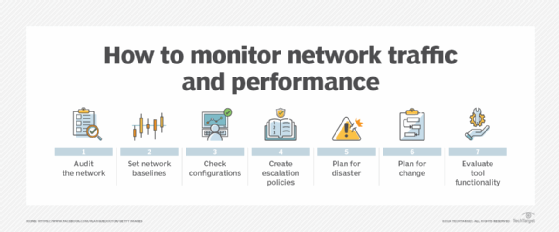How to monitor network traffic in 7 steps
Effective network monitoring is an ongoing process that requires the right tool set to gain visibility into infrastructure service quality. These steps can help network teams fine-tune network monitoring strategies.
In this era of hybrid infrastructure models, it can be complicated for network teams to get clarity on network performance. As network administrators grapple with how to track network activity as well as how to ensure operational excellence and consistency, they routinely seek guidance on best practices and tools for the task.
Enterprise infrastructure underpins all ongoing digital transformations. The network facilitates critical operations, and it connects more systems and network devices than ever before. Like the businesses and governments that depend on it, the enterprise network has become more dynamic and connected to third-party cloud infrastructure. Because organizations are so reliant on that network being fast, they expect secure and reliable operational excellence.
Network traffic monitoring tools capture traffic data and metrics that are essential for analysis and optimization. But selecting the right tools and deploying them effectively require a good understanding of the organization's network infrastructure, priorities and challenges.
The following seven steps can help network administrators monitor network traffic to support a reliable and consistently high-performing enterprise network infrastructure.
This article is part of
What is network management?
1. Take stock of the network
When managing any network environment, network admins need an accurate inventory of all the network devices and applications running on the network. Large and complex networks are more difficult to monitor, especially through manual methods. As such, network teams can use a network mapping tool that automatically discovers endpoints, network connections and topology.
These tools help provide a complete asset inventory and describe the interdependencies within the network. They can check the health and status of network devices, show traffic flows and find configuration details. Many asset management tools apply analytics and AI to identify opportunities to improve configurations and eliminate unnecessary redundancies. Network should periodically check for asset changes.
2. Set network baselines
It's important for network teams to establish a baseline that shows normal traffic activity. Teams can then use this baseline to understand when anomalous network activity happens, which could indicate a network issue or potential security breach.
Network managers can use data capture or traffic sniffing tools, such as Wireshark or tcpdump, to collect information on network activity over time. Data capture should be an ongoing process as changes in the network are constant.
Some networking tools use machine learning to capture baseline information to conduct network traffic analysis. These tools compare the baseline to traffic changes, which streamlines root-cause analysis, troubleshooting and changes to improve service levels.

3. Check and refine configurations
Network monitoring is an ongoing process, not a one-off activity. Continuous network monitoring is one way to identify when devices aren't configured correctly. Teams can monitor and analyze network performance in conjunction with network configuration management software. This process help teams identify opportunities to refine device configurations, optimize bandwidth and provide faster data transfers across the network.
Graphical reporting tools can make it easier for network managers to assess and address service-level issues. Progress in analytics helps teams find opportunities to improve network performance and efficiencies.
4. Apply escalation procedures
Network teams need a formalized policy in place that can alert the appropriate IT staff member when a network issue occurs. Automated tools can launch this process and escalate the incident to the appropriate expert as more information becomes available. These tools can also alert IT and line-of-business professionals when an issue might affect adjacent areas or operations.
It's crucial for enterprise IT teams to update their escalation template to avoid wasted time and extended outages.
5. Plan for disaster, aim for continuity
An underperforming network can impede productivity. An outage can completely derail operations, resulting in costly losses. Effective network monitoring and performance management can help network teams spot issues before they become full-blown problems and minimize their effects on the business.
To ensure high availability and limited downtime, however, network teams needs to have a business continuity and disaster recovery plan. This plan should detail the appropriate failover measures, policies and recovery procedures. It's critical for teams to architect the network with no single point of failure to avoid major extended outages.
6. Plan for change
Networks are constantly evolving as organizations grow or consolidate. Broad adoption of cloud computing services also has an effect as more enterprises adopt a hybrid IT model, with some resources on premises and others running in third-party environments.
It's important to continually assess how changes in the business might affect the network and then adjust accordingly. To plan appropriately, network teams must understand business objectives, measure network performance, develop change management procedures and perform frequent network testing.
7. Evaluate tool functionality
Like the network, the tools to monitor and manage it are always changing. Network managers need to regularly evaluate if the network monitoring and performance management tools in their arsenal have the appropriate features and functionality. The IT organization also needs to make sure staff members have the appropriate training to get the maximum benefit from these tools.
Tools for monitoring network traffic
Network teams can use vendor or open source network monitoring tools to monitor network traffic. Some tools provide a discrete capability, such as asset discovery, while others offer integrated network monitoring and performance management features. Vendors are also implementing AI and analytics into many of these tools to improve the quality and accuracy of network monitoring.
As IT departments reassess their needs periodically, they should look to fill gaps in their monitoring capabilities, either with standalone options or a fuller feature replacement.
Network monitoring requires several elements to be successful, including automated inventory discovery, to map the network properly. Alerting and reporting tools provide the notifications network teams need to stay on top of issues and other reports to fine-tune configurations.
Fault isolation and troubleshooting sheds light on exactly where the issue is. Network traffic analysis gives network managers insight into what the source of the problem is so they can expedite remediation and limit undesirable outcomes.
3 network monitoring challenges
The following are common challenges when monitoring the network.
Visibility into opaque networks
It can be challenging for network teams to get an accurate and clear picture of traffic activity on enterprise networks that are both highly virtualized and distributed even with the best tools in hand. This challenge grows more complex with cloud environments, where it's difficult to see what is happening in near-real time. While tools are improving, there's still a long way to go in monitoring certain environments, such as multi-cloud and hybrid architectures.
Mapping the network and establishing a baseline
The dynamic nature of the network today can make it problematic to map the interdependencies. Without this mapping, though, network teams lose a key insight into the performance and context of traffic flow.
At the same time, the ever-changing disposition of the network makes it challenging to get a real performance baseline. Without this baseline, it is impossible to gauge service-level issues or make proactive configuration adjustments.
Getting optimal configuration
One of the biggest benefits of effective network monitoring is the ability to fine-tune performance through configuration changes. Determining where and what to do to make these adaptations can be daunting. If a device is misconfigured, the outcome could be serious. Network teams need to have consistent change management policies that require testing to ensure the system is configured properly.
Editor's note: This article was updated to expand information about best practices.
Amy Larsen DeCarlo has covered the IT industry for more than 30 years, as a journalist, editor and analyst. As a principal analyst at GlobalData, she covers managed security and cloud services.








